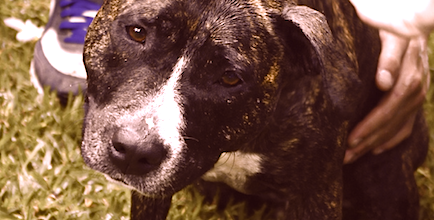Von Willebrand Disease: What You Need to Know
This disease causes blood to have trouble clotting, making surgical procedures for our furry friends risky.

What would you do if your 1-year-old, apparently healthy pup was out-of-the-blue diagnosed with a potentially life-threatening health condition like Von Willebrand disease?
Unfortunately, this isn’t a hypothetical question.
In fact, it’s a dilemma that one of my clients recently had to face.

Don’t leave your pet’s safety to chance
Sign up for Petful recall alerts today.

Post-Op Complications
Meet Kerry, a stunning Irish Wolfhound: tall, elegant and slightly aloof.
He’d just reached his 1st birthday, and as a sort of coming-of-age present, he was booked in for neutering.
The surgery itself went smoothly: all blood vessels securely tied off, no bleeding and intradermal sutures so neat it was hard to see where the incision had been made.
Unhappily, a few hours later, Kerry developed complications. There was blood on his bedding.
Checking Kerry out, I found that his scrotum had swollen to the size of a small eggplant, and there was a steady drip-drip-drip of blood from the incision.
None of this made sense. There had been no problem during surgery and everything was securely tied off. Why bleed now?
The answer niggling at the back of my mind was that Kerry had a clotting disorder.
Emergency Treatment
To stem the seepage, a pressure bandage was applied to the surgical site.
Kerry was also put on an IV to replace the fluid lost through bleeding. In addition, a small blood sample was taken to monitor the blood loss and check for clotting factors.
Kerry was the “walking wounded” and not yet critically ill, but the writing was on the wall if he continued to bleed. With this in mind, he was hospitalized for close monitoring.
Happily, he had a good night. Had Kerry continued to bleed, he would have needed a blood transfusion to replace the lost fluid. This also has the added benefit of topping up his ability to clot blood from the clotting factors present in the donor blood.
Kerry went home and continued to improve, with his scrotum reducing to the size of a small apple over the next few days.

Von Willebrand Disease
The blood test came back positive for Von Willebrand disease.
This condition means the dog doesn’t produce enough Factor VIII or Von Willebrand’s factor.
The job of Factor VIII is to glue a clot together so that it plugs a gap. Without it is like building a brick wall without mortar — it’s easy to push the wall over.
In practical terms, this means the affected dog produces poor-quality blood clots that break up too easily.
This is a hereditary condition, meaning it’s passed down from the parent dogs to the pups. (Obviously, those parents should not be bred from again, and neither should affected dogs be bred from.)
Timing
Kerry had seemed normal up until his surgery.
This is typical in many cases because it’s usually an operation or an injury that first highlights their clotting difficulties.
You see, these dogs have a certain amount of Factor VIII circulating, which they use up plugging small “holes” with the bumps and knocks of everyday life. However, when the dog has surgery, even with the best hemostatic control, their supply of Factor VIII soon get used up.
And then the dog starts to bleed.
It’s also worth knowing that this isn’t a one-size-fits-all condition. Some dogs with Von Willebrand have only slightly low levels, while others will be critically low.
This has implications for how well or poorly they clot blood in an emergency.

Clotting Disorder Symptoms
Be aware that clotting disorders are not uncommon.
The telltale signs tend to be:
- Prolonged blood spotting after minor procedures, such as nail clips
- Bleeding from an injection site
- Nosebleeds
- Bleeding from the gums after chewing
- Regular evidence of blood in pee or poop
- Easily bruised skin
Some breeds are more likely to have Von Willebrand disease than others. A few of those predisposed include:
- Corgis
- Dachshunds
- Dobermans
- German Shepherd Dogs
- Golden Retrievers
- Miniature Pinschers
- Papillons
- Poodles
- Schnauzers
If you suspect your dog has a clotting problem, contact your veterinarian immediately.
Listen to this vet voice her concerns over a Doberman Pinscher’s imminent neutering procedure:

Treatment of Von Willebrand Disease
Unfortunately, there is no cure for Von Willebrand disease.
However, once a case is diagnosed, this gives you back some power because you know minor injuries can lead to prolonged blood loss, so visit the vet right away.
Also, it’s good to avoid unnecessary surgery. Even dental extractions can cause problems, so take dental care seriously and start brushing those teeth to keep them in good condition.
When surgery is unavoidable, your vet can give an injection for 4 consecutive days ahead of planned surgery, which stimulates increased production of Von Willebrand’s factor. In addition, your vet will blood type the dog and order blood products ahead of the op, just in case they bleed.
Then there’s prevention. Do you or do you not change the dog’s lifestyle?
Reducing the risk of injury is important, but so is leading a full and active life.
- If you stop an active dog from running and playing, this has a psychological impact on their mental health.
- In addition, they’re going to gain weight, and we know that obesity has a negative impact on health.
This dilemma is an example of being stuck between a rock and a hard place. What to do for the best?
Kerry’s Life With Von Willebrand Disease
Kerry’s human was admirably philosophical.
She has a young dog who’s full of energy and who lives to run.
Rather than wrap him up in cotton wool to reduce the risk of injury, she’s determined he’ll lead a normal life and continue playing with his pet pals and romping around the fields. Her reasoning is that it’s better to have a short happy life than a long frustrated one.
I can see her point of view, and yet the thought of Kerry cutting himself on barbed wire makes me distinctly uneasy.
In the fullness of time, I guess we’ll see what happens.
References
- “Canine von Willebrand Disease.” Cornell University College of Veterinary Medicine. 2016. https://www.vet.cornell.edu/animal-health-diagnostic-center/laboratories/comparative-coagulation/clinical-topics/canine-von-willebrand-disease.
- Williams, Krista, BSc, DVM, and Ernest Ward, DVM. “Von Willebrand’s Disease in Dogs.” VCA Hospitals. 2018. https://vcahospitals.com/know-your-pet/von-willebrands-disease-in-dogs.
- “Von Willebrand Disease.” EeClinpath. 2013. http://eclinpath.com/hemostasis/disorders/von-willebrands-disease/.
- Brooks, Wendy, DVM, DABVP. “Von Willebrand’s Disease in Dogs.” Veterinary Partner. March 13, 2004. https://veterinarypartner.vin.com/default.aspx?pid=19239&id=4952042.







